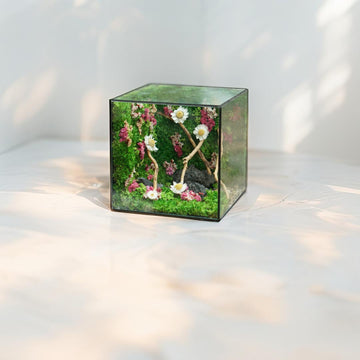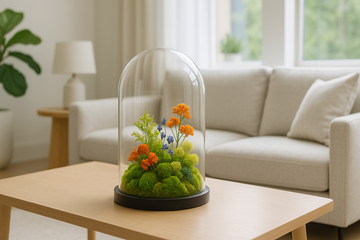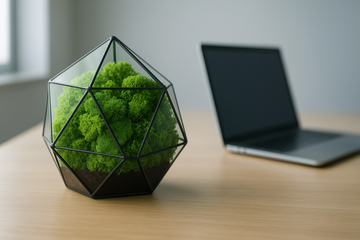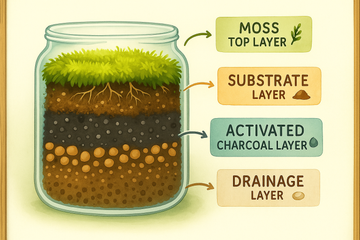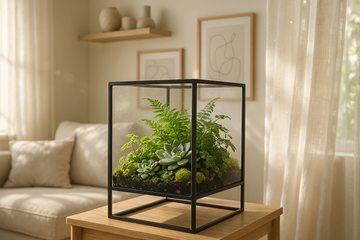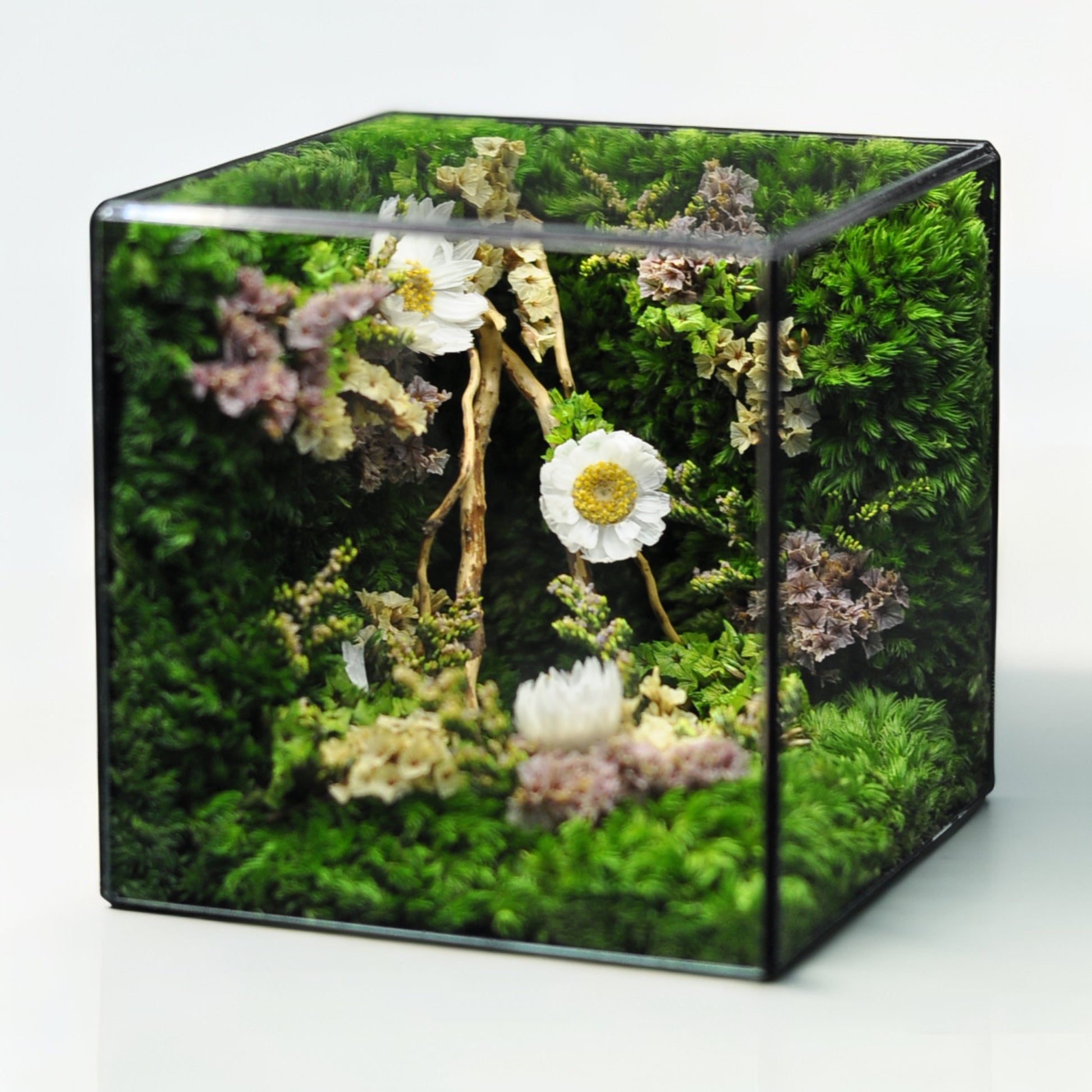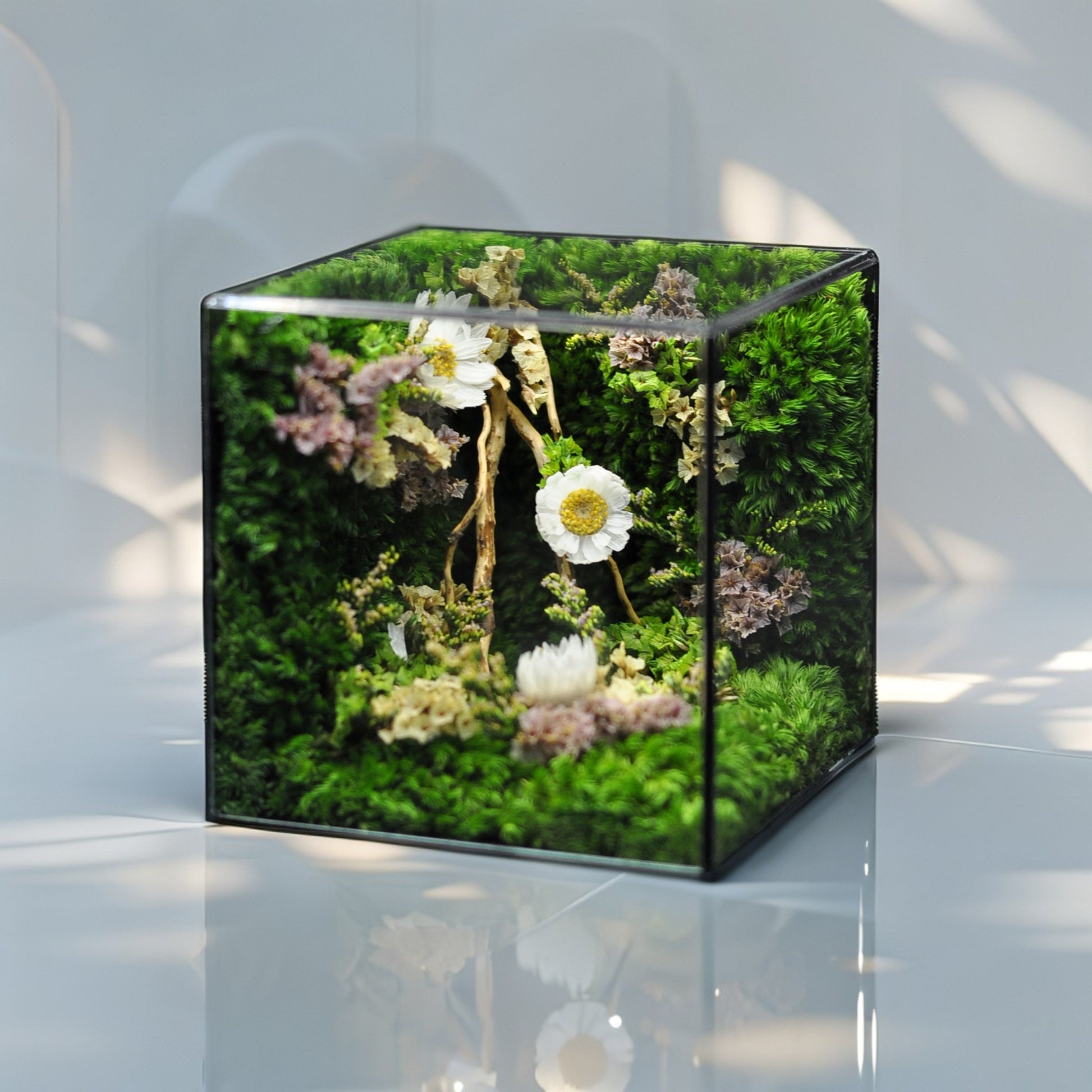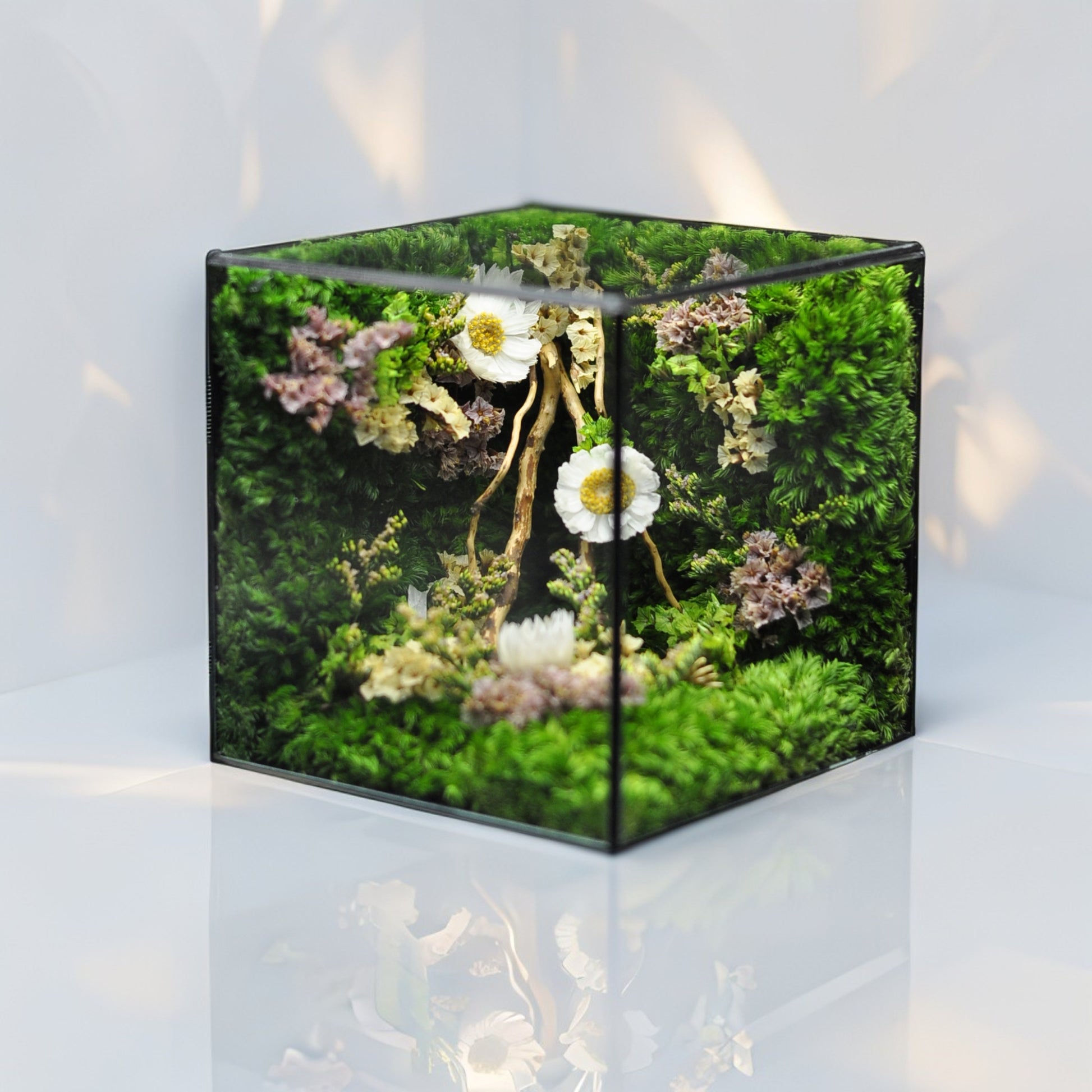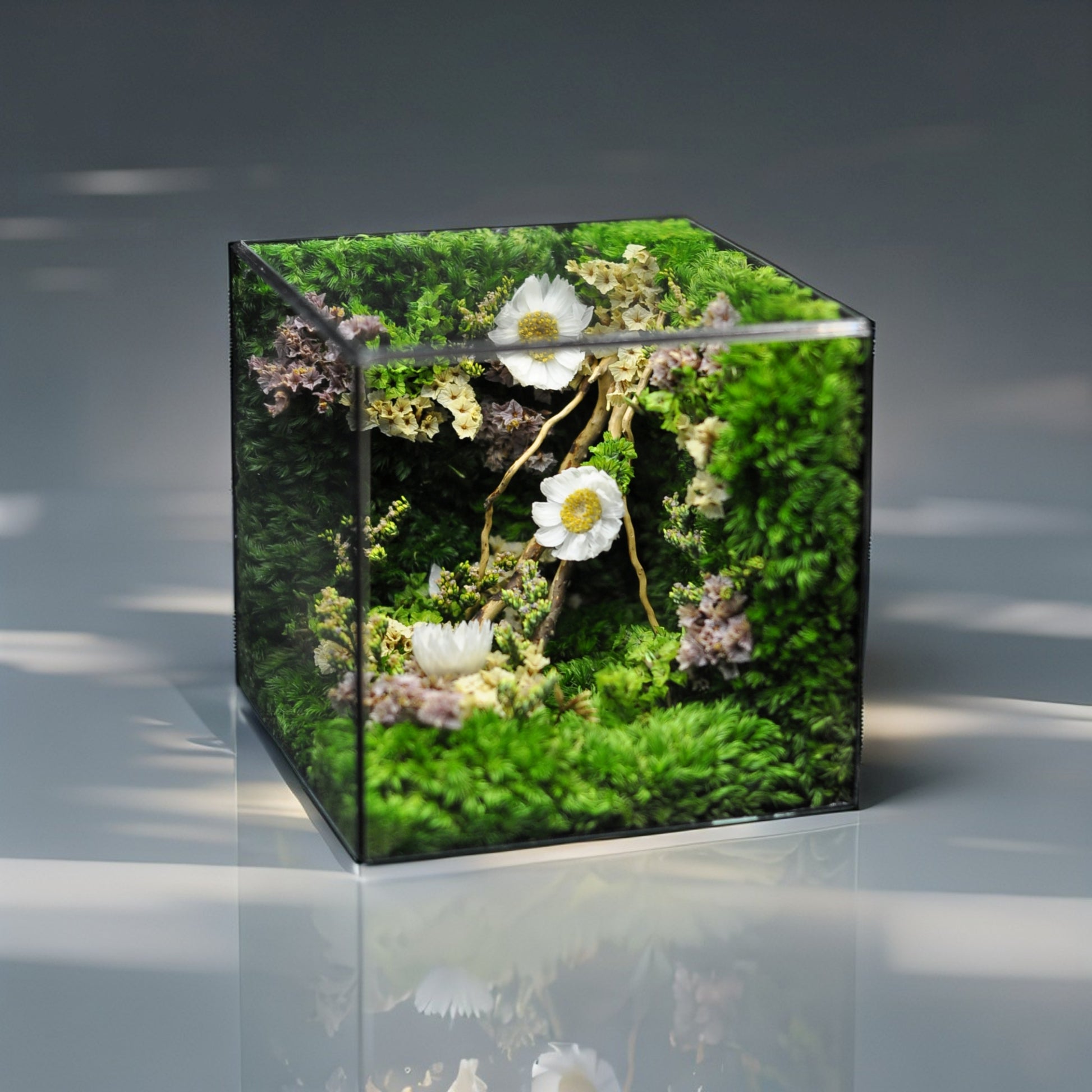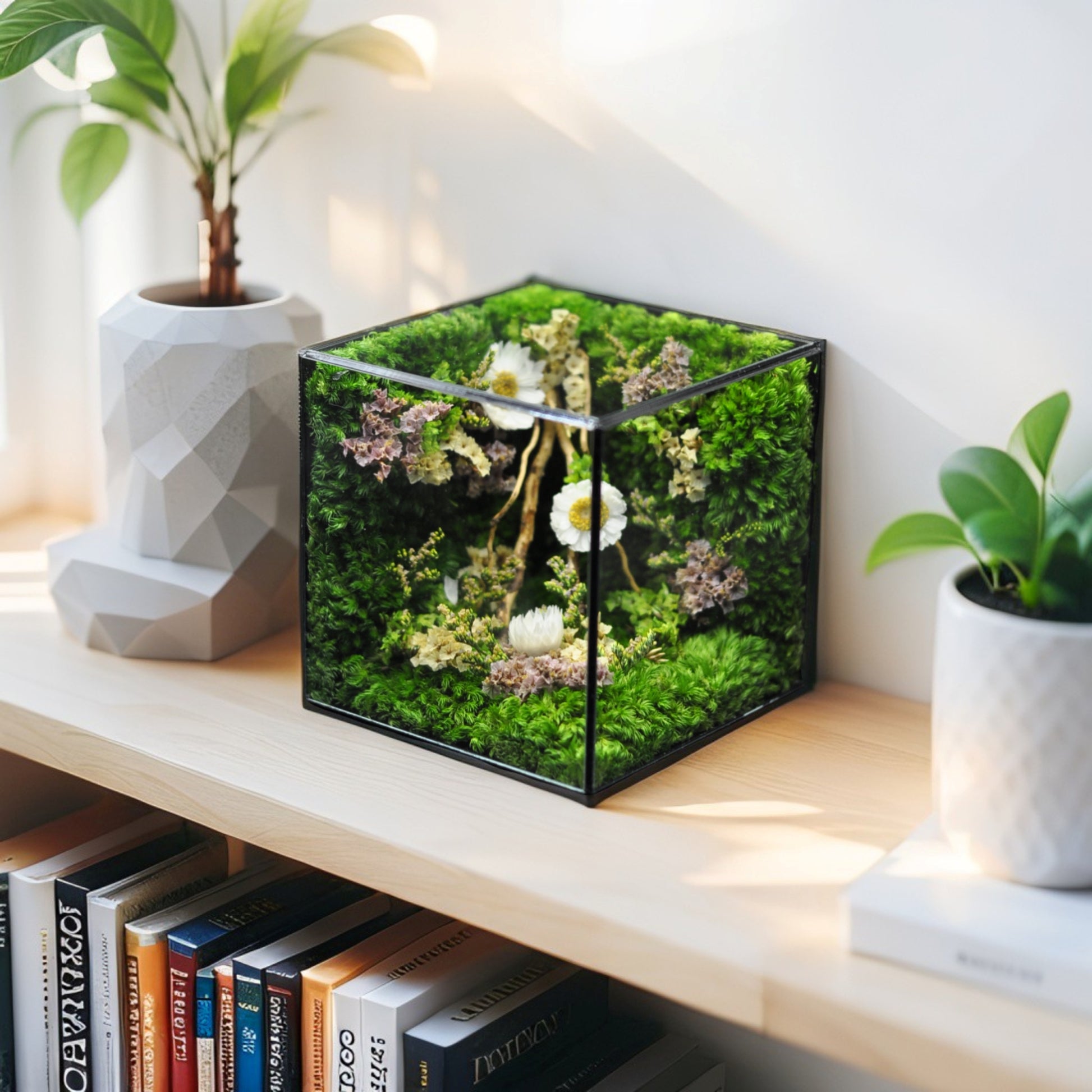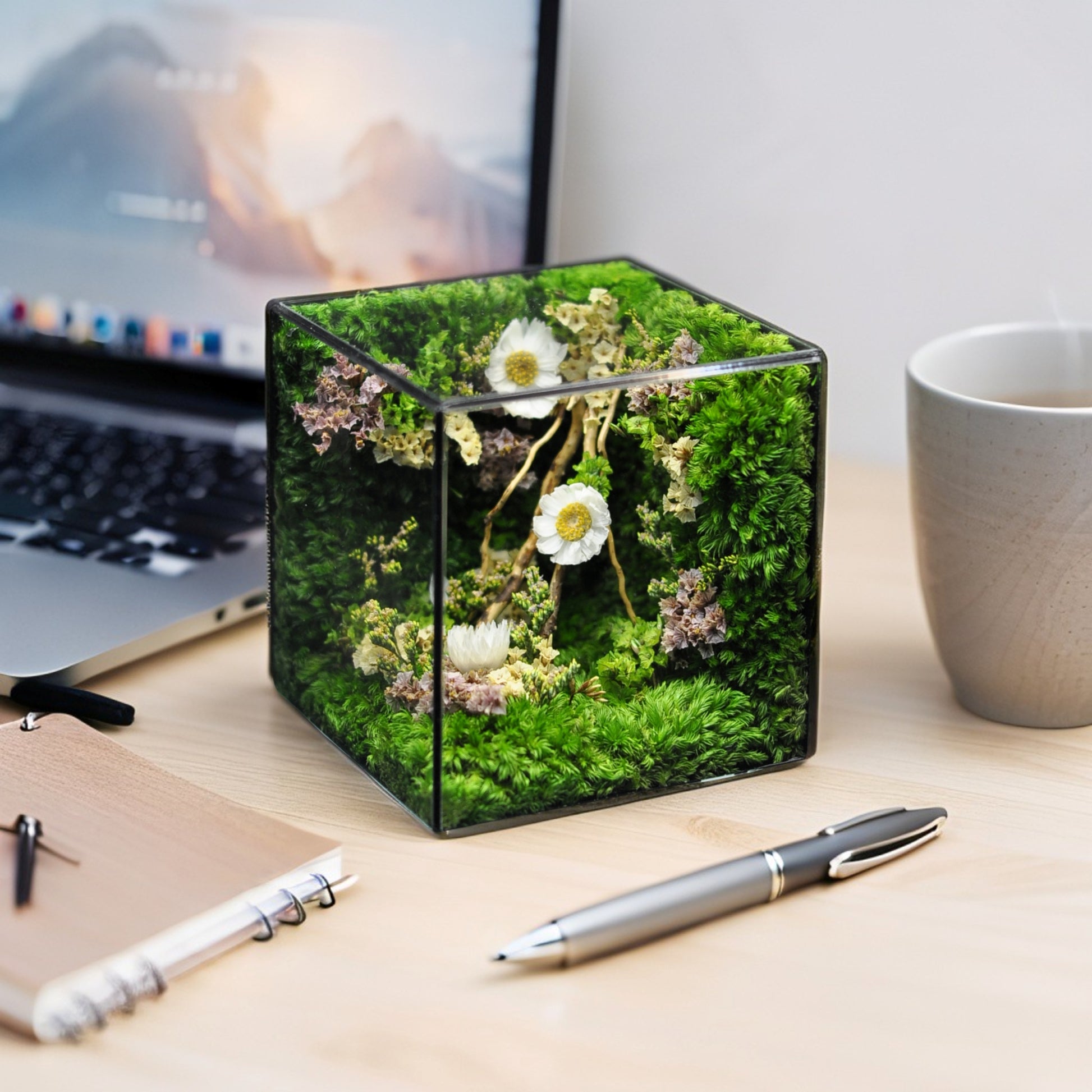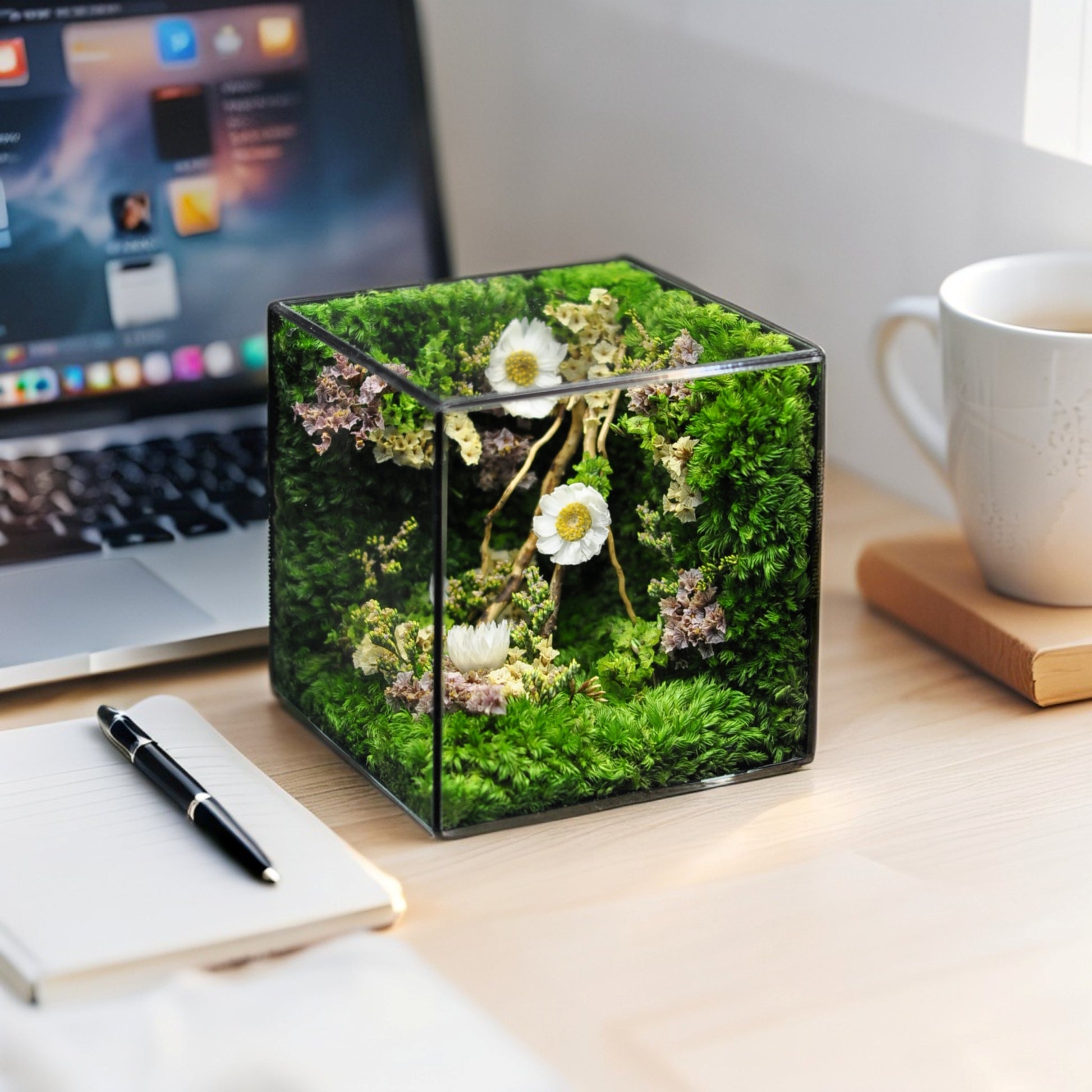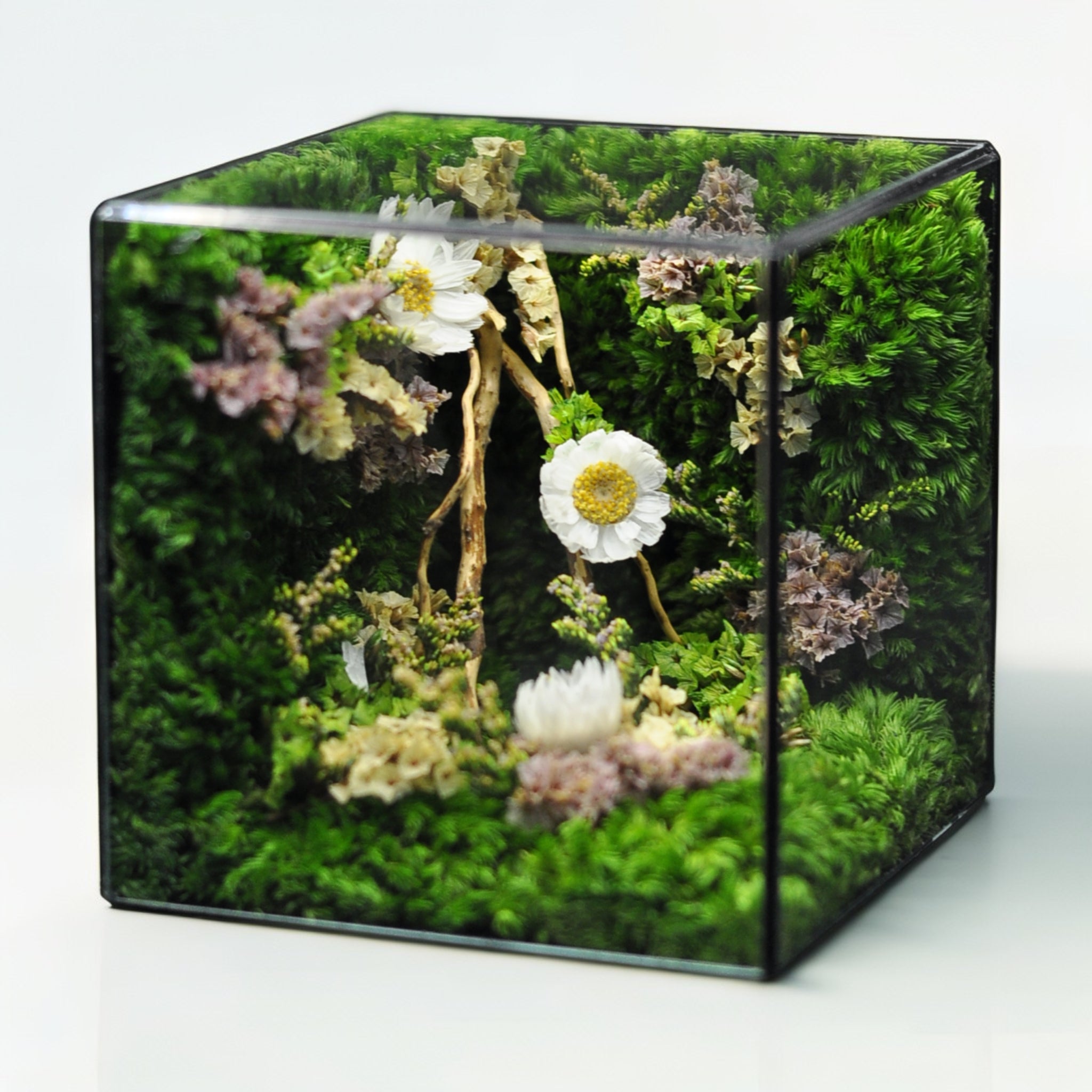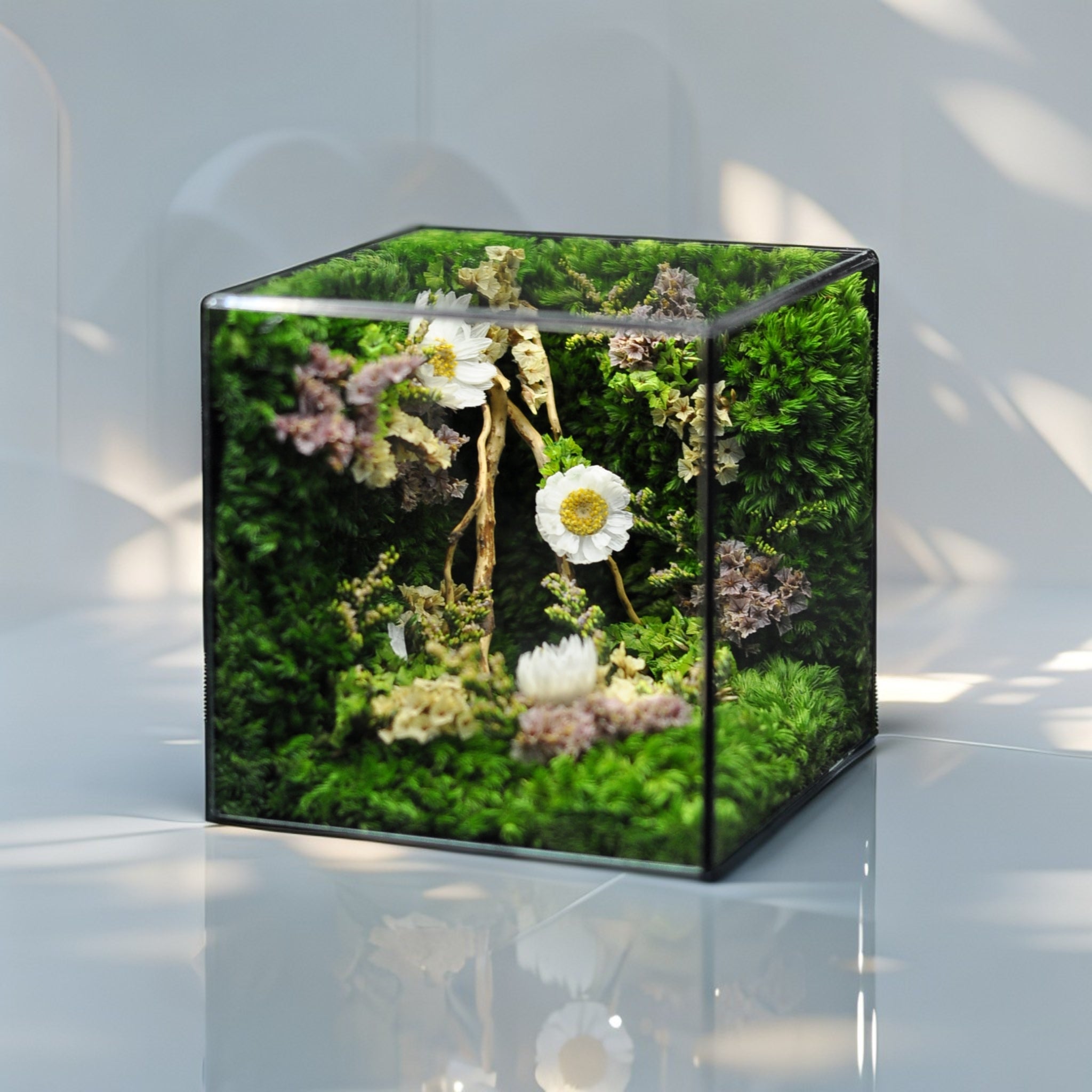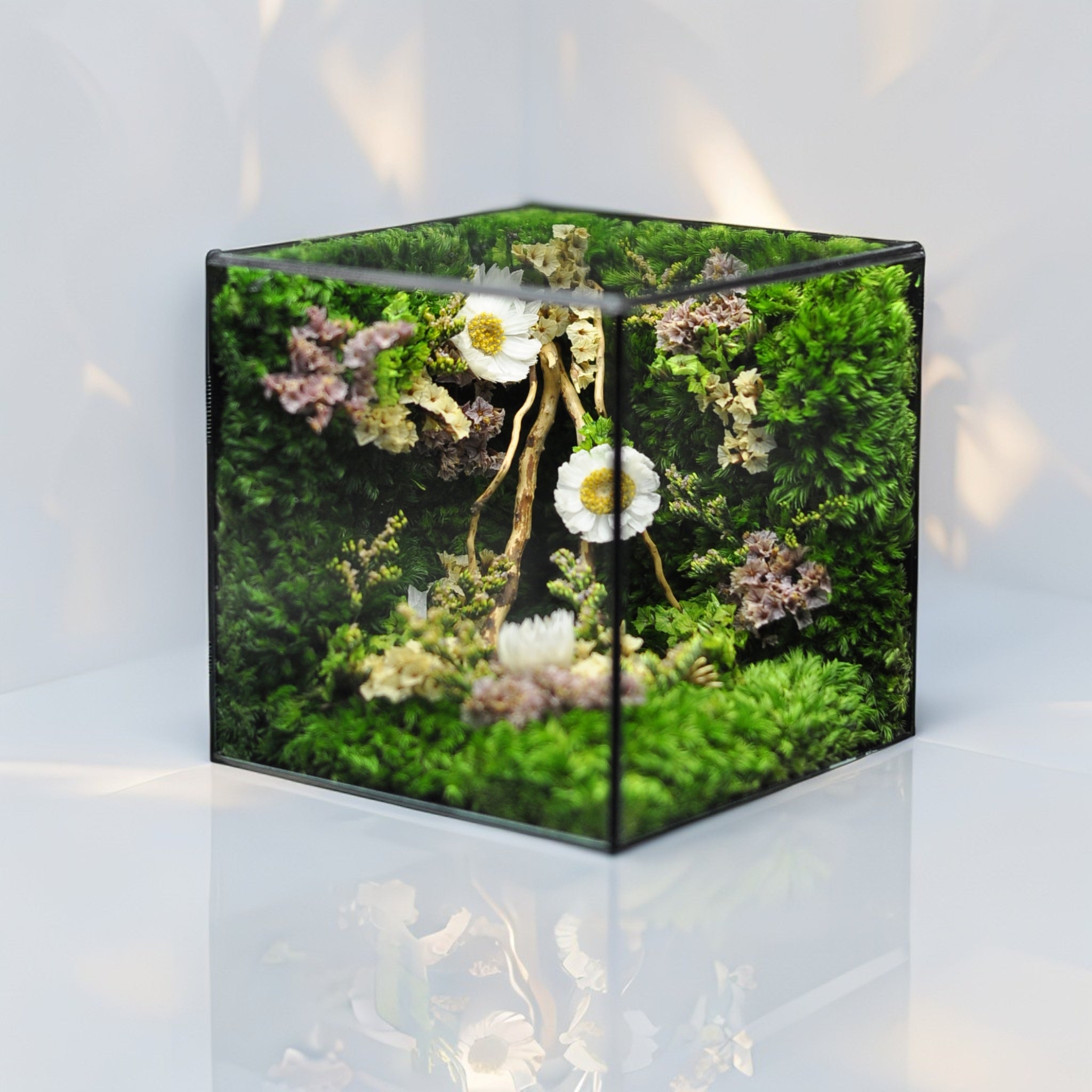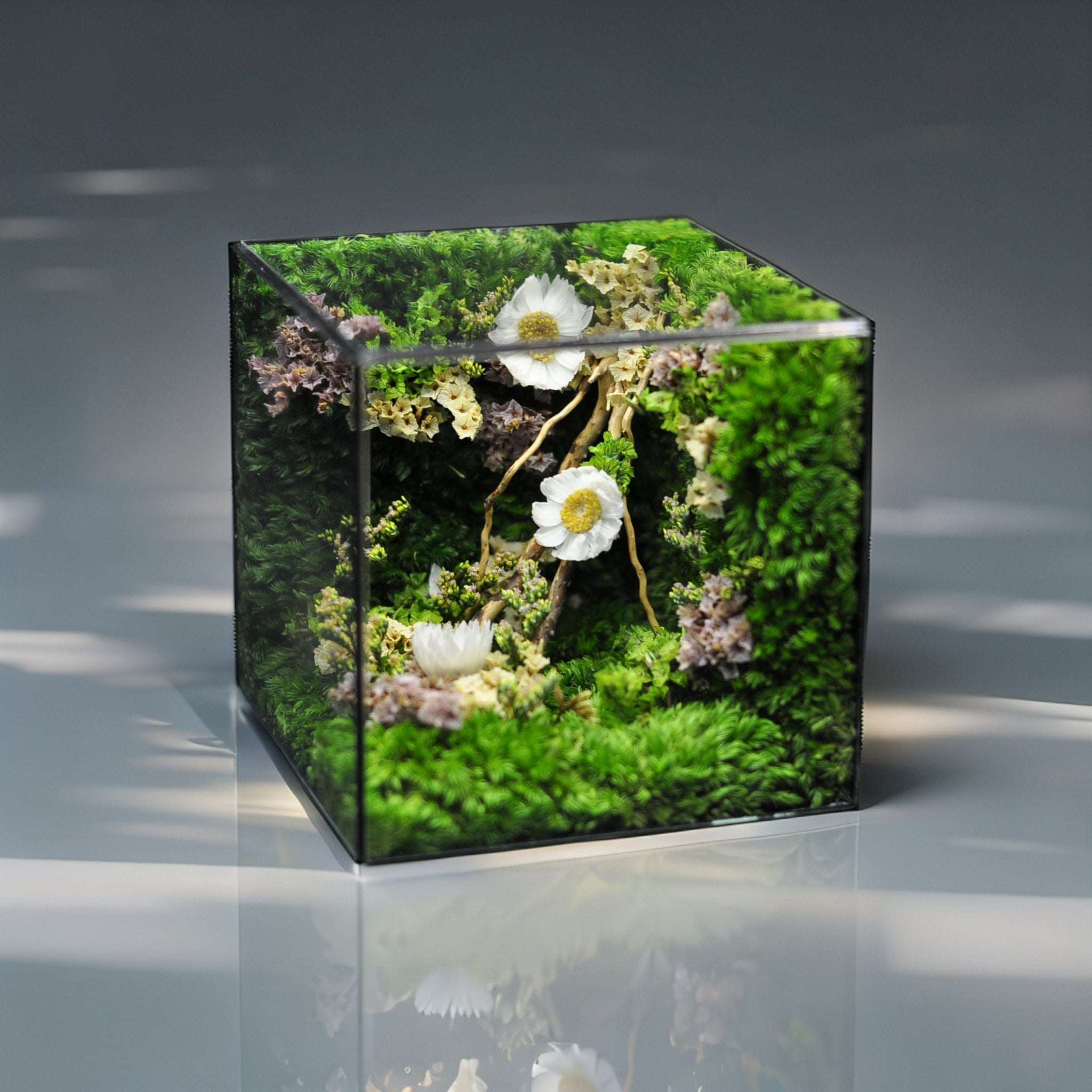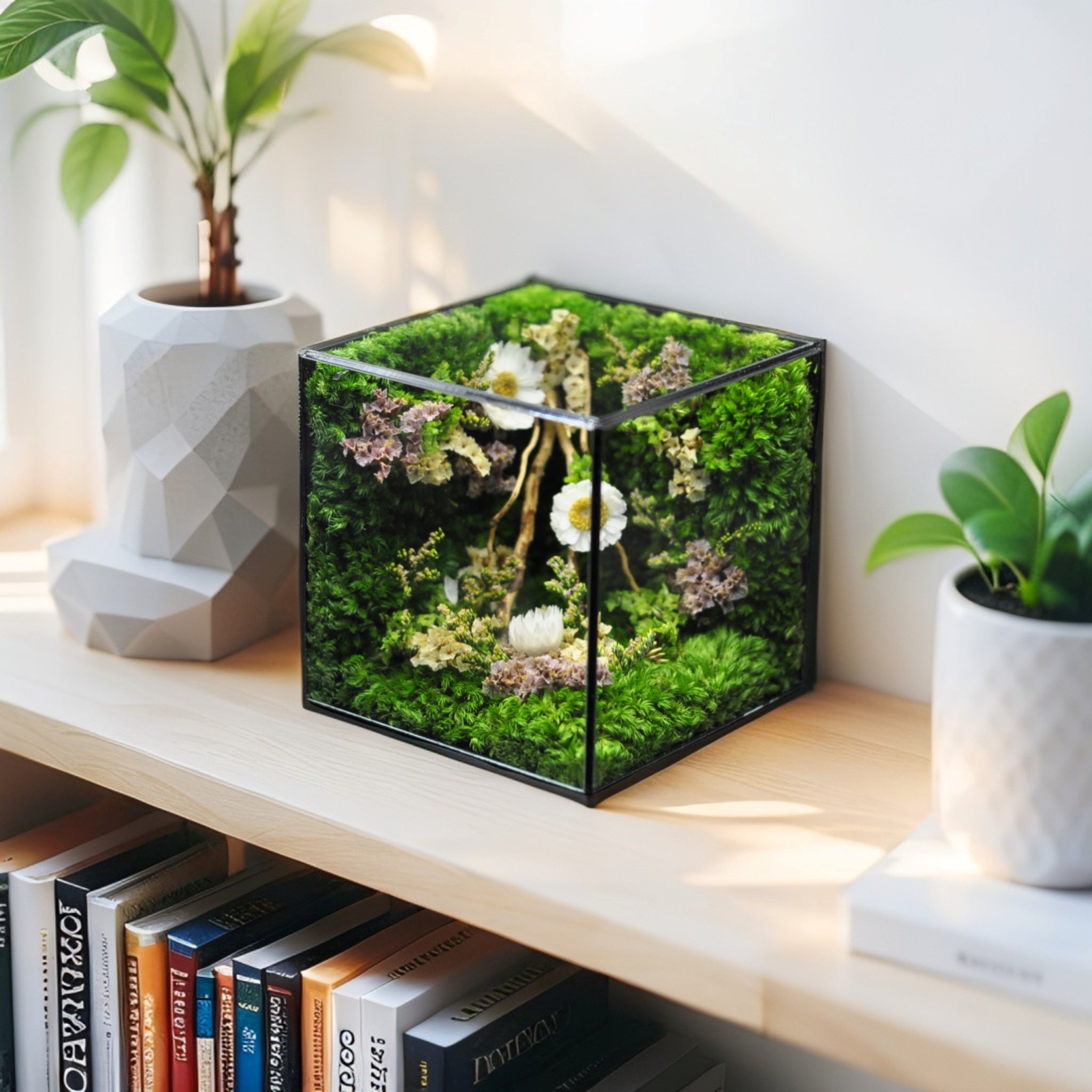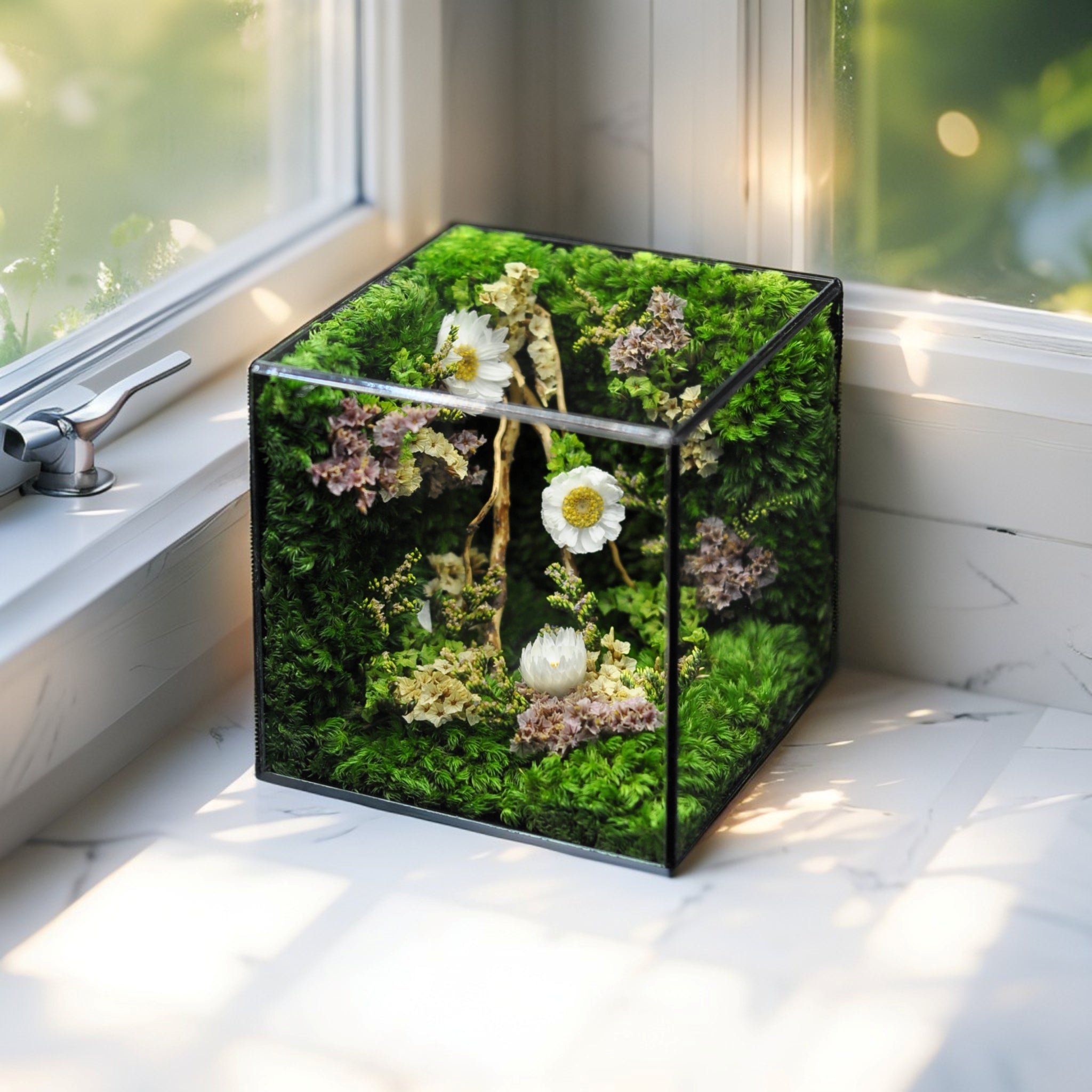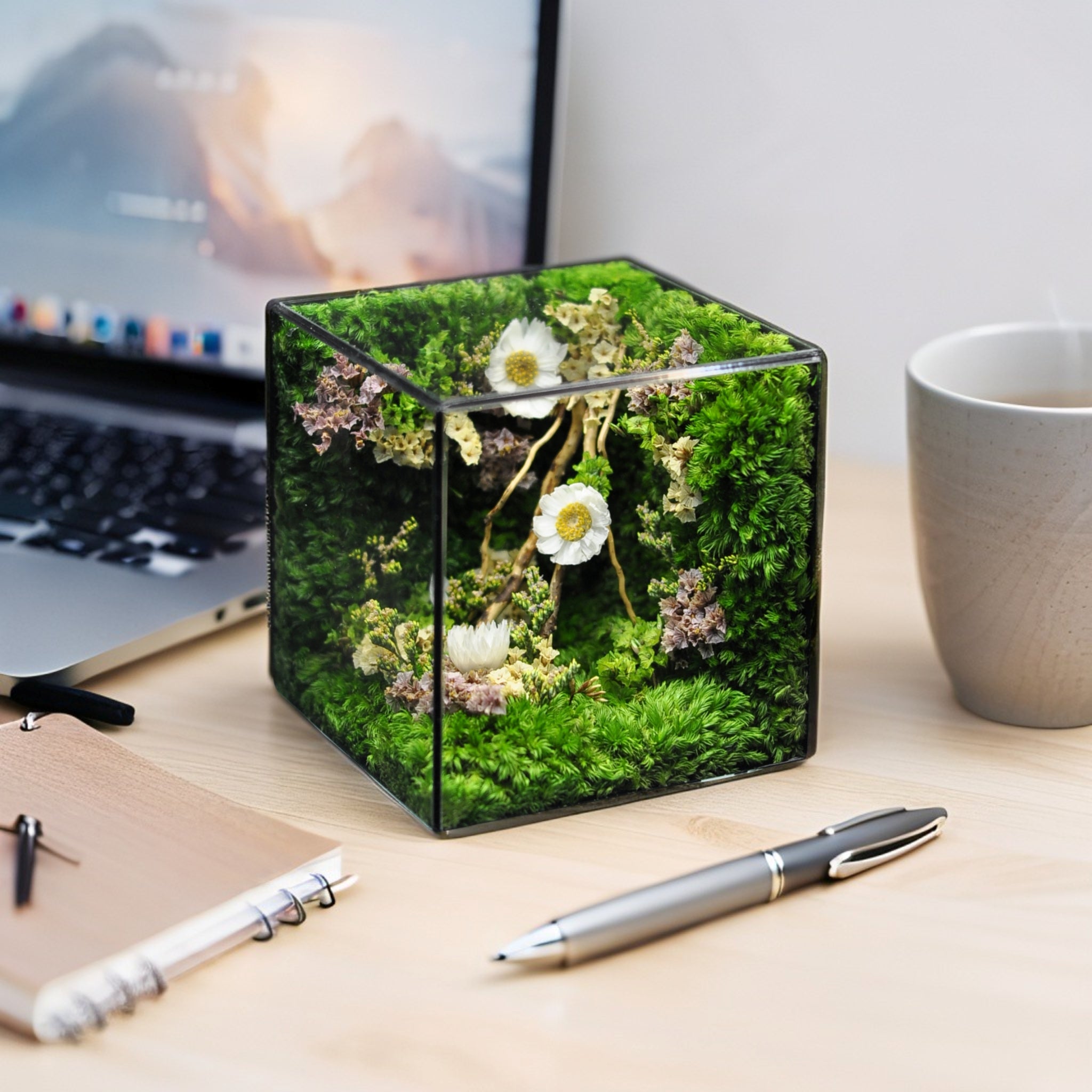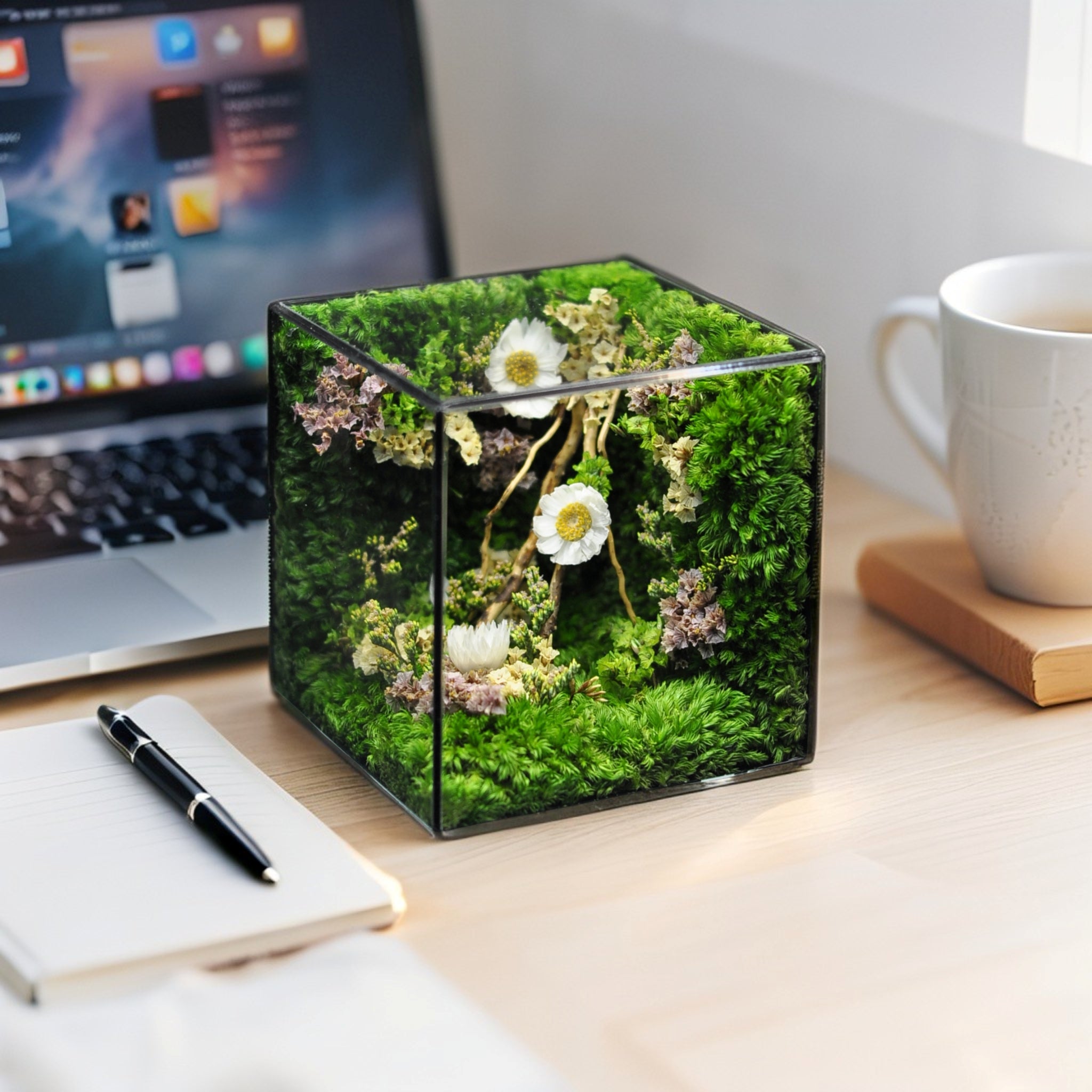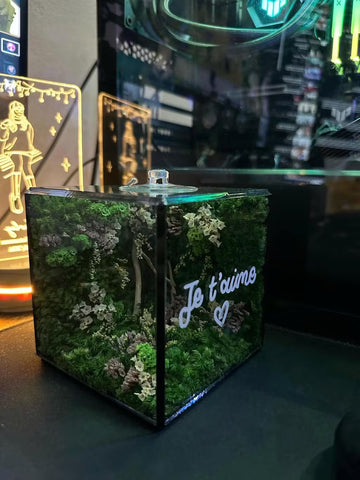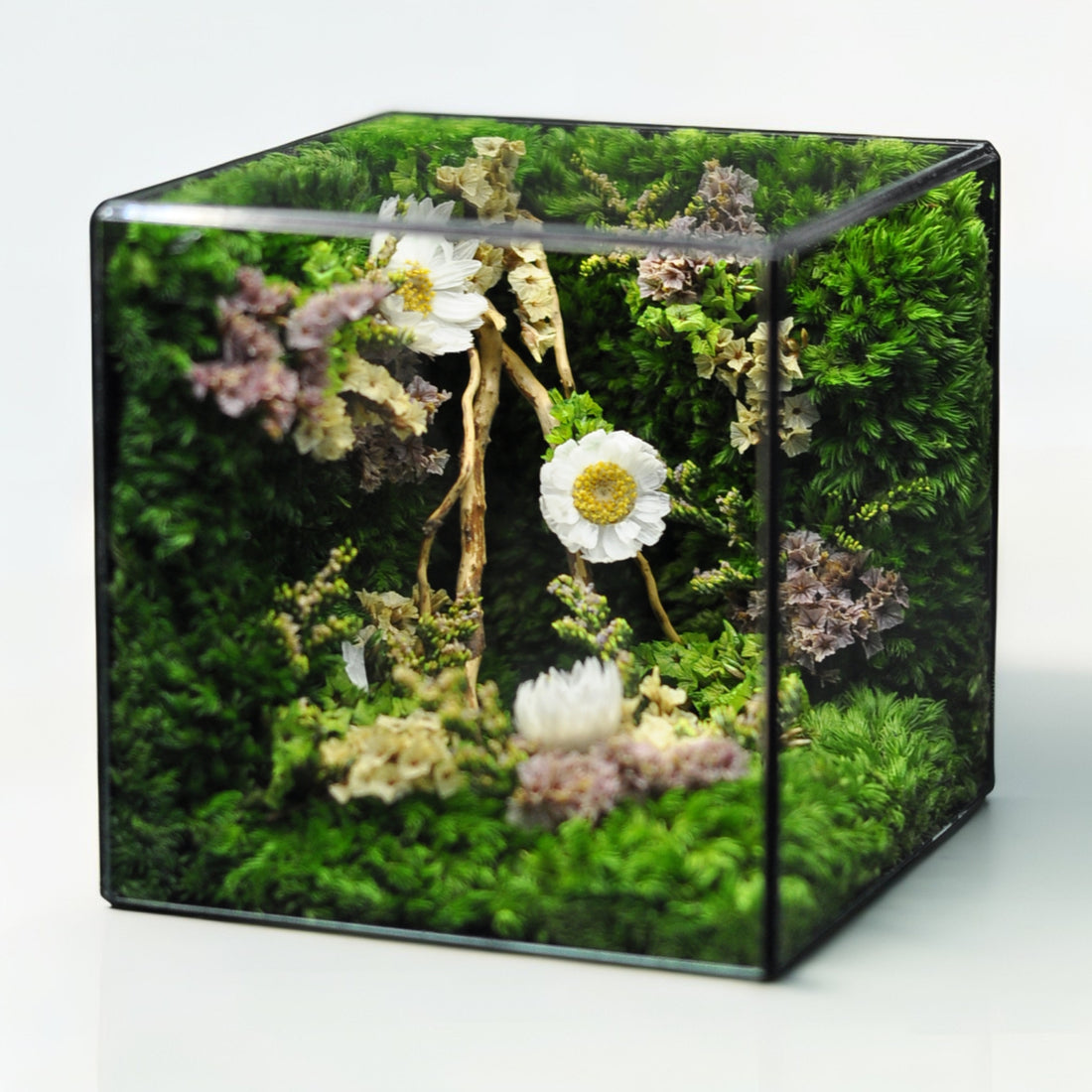Key Takeaways
Terrariums are miniature glass-bound ecosystems that unite botanical science, creative design, and wellness benefits. Below are the key takeaways covering their definition, history, ecological mechanics, types, construction essentials, plant selection, upkeep, and the subconscious stress relief and decorative flair they introduce into any space.
- Master terrarium fundamentals: A terrarium is a sealed or open glass container housing a self-contained water and carbon cycle that sustains select plants with minimal intervention.
- Chart the terrarium’s historical roots: From 19th-century Wardian cases to modern decorative niches, terrariums evolved as botanical study tools and ornamental accents.
- Harness ecosystem science: Layer drainage gravel, activated charcoal, soil, and plants to replicate natural water condensation, nutrient cycling, and gas exchange.
- Select your ideal terrarium type: Choose between closed, open, or thematic setups (e.g., tropical, succulent, aquatic) based on humidity needs, light availability, and aesthetic goals.
- Equip yourself with essential materials: Gather clear glass vessels, activated charcoal, drainage substrates, potting mix, tweezers, moisture meters, and decorative elements before you begin.
- Follow a proven step-by-step DIY method: Build in layers—drainage, charcoal, soil—then position plants, seal or ventilate appropriately, and monitor moisture levels.
- Optimize plant choice and placement: Use low-light fittonias, ferns, and moss in closed terrariums; sun-loving succulents and cacti in open designs; arrange by size and growth habit.
- Sustain your terrarium’s health: Trim overgrowth, wipe glass, rotate for even light, control humidity, and inspect regularly for mold to ensure long-term balance.
- Elevate wellness and interior design: Beyond horticulture, terrariums foster mindfulness, reduce stress, and serve as personalized biophilic décor accents.
With an understanding of terrarium fundamentals, history, science, types, materials, and the added wellness and design perks, you’re now prepared to dive into the comprehensive, step-by-step guide ahead to build and sustain your perfect miniature ecosystem.
Introduction
Imagine transforming a simple glass container into a thriving, miniature ecosystem that brings life and tranquility to your space. This fascinating interplay of biology and design—a terrarium—offers not just a captivating decoration but also a unique opportunity for mindfulness and wellness in today's fast-paced world.
Understanding the terrarium meaning is your first step towards crafting a self-contained environment that requires minimal effort yet rewards you with lush greenery and aesthetic allure. This guide will walk you through everything from the terrarium's rich historical roots to the essential materials needed for construction, alongside practical tips for plant selection and maintenance. Whether you're a seasoned gardener or a curious novice, you'll be equipped to build and sustain your own stunning little biosphere.
Let’s dive into the enchanting world of terrariums, exploring their definition, types, and all the insights necessary to create your perfect indoor sanctuary.
Terrarium Meaning: What Is a Terrarium?
Terrarium meaning conjures images of lush miniature forests thriving behind glass. But what exactly is a terrarium? A terrarium is a transparent, sealed or open container that houses a self-contained ecosystem of plants—and sometimes small invertebrates—in a controlled environment. By harnessing natural processes like evaporation, condensation, and nutrient cycling, terrariums bring low-maintenance greenery into homes and offices with minimal care.
Definition and Etymology of Terrariums
Terrarium Meaning and Definition
A terrarium is a miniature ecosystem enclosed in a glass or clear-plastic vessel. Key characteristics include:
- A transparent container that allows light for photosynthesis
- Either sealed (closed) or open to ambient air
- A layered substrate system for drainage, filtration, and plant support
- A miniature water cycle: evaporation → condensation → precipitation
Terrariums excel at maintaining humidity and light levels to support a variety of plants in small indoor spaces.
Origins of the Term “Terrarium”
The word “terrarium” blends the Latin terra (earth) with the suffix arium (place for). The term first appeared in print in 1852, according to the Oxford English Dictionary [4], marking the transition from functional Wardian cases to decorative glass gardens.
History and Evolution of Terrariums
From Wardian Cases to Modern Decor
In 1829, Nathaniel Bagshaw Ward patented the Wardian case, a sealed glass enclosure designed to transport exotic plants across long sea voyages. By the Victorian era, these cases became parlor curiosities showcasing tropical flora. Fast-forward to the 1970s, when succulent and cactus terrariums debuted at craft fairs. Between 2010 and 2020, Google Trends recorded a 180% increase in searches for “DIY terrarium” [3], driven by social media and the rise of biophilic design. Today, terrariums are as likely to be found on office desks as they are mounted on feature walls in urban apartments.
Science Behind Terrariums: Water and Carbon Cycles
The Self-Sustaining Ecosystem Mechanism
Terrariums rely on three core processes to thrive:
- Drainage and Filtration
- A bottom layer of gravel or clay pebbles (2–5 mm) prevents waterlogging.
- A 1 cm layer of horticultural-grade activated charcoal adsorbs toxins and odors.
- A 5–10 cm potting mix with particle sizes of 1–4 mm balances aeration and moisture retention.
- Water Condensation Cycle
- Evaporation from soil and foliage raises humidity.
- Condensation on the vessel walls returns water to the substrate.
- In closed terrariums, this cycle maintains moisture with virtually no external watering [5].
- Gas Exchange and Photosynthesis
- During daylight, plants convert CO₂ to O₂; at night, they respire.
- A balanced plant-to-air ratio prevents CO₂ depletion in sealed systems.
- Ambient light often suffices, but full-spectrum LED grow lights boost rates when needed.
Pro Tip: Choose low-iron glass (3–5 mm thick) for maximum light transmission and UV clarity.
Data & Evidence: Research on Terrarium Microclimates
- A 2012 study in the Journal of Plant Research found that closed terrariums stabilize relative humidity at 85–95% within two weeks of sealing [5].
- Research in Soil Biology & Biochemistry (2015) highlights how microbial nitrification and mineralization in confined substrates recycle nutrients, supporting plant growth [6].
- Measurements published in the Journal of Environmental Horticulture (2017) report photosynthetic rates of 3–5 µmol CO₂·m⁻²·s⁻¹ for common terrarium plants under ambient indoor lighting [7].
Types of Terrariums: Closed, Open & Thematic Variations
Closed vs. Open Terrariums
Closed Terrariums
- Sealed or partially sealed vessel mimicking a greenhouse
- High humidity (80–100% RH), ideal for ferns, mosses, and tropical species
- Self-watering cycle minimizes maintenance
Open Terrariums
- Wide opening or no lid for greater air exchange
- Moderate humidity (40–60% RH), perfect for succulents, cacti, and air plants
- Requires watering every 1–2 weeks, depending on substrate moisture
Thematic Setups: Tropical, Succulent & Aquatic
Tropical Terrariums
Enclosed environment, rich organic mix, constant moisture
Plants: Nephrolepis exaltata (Boston fern), Fittonia albivenis (nerve plant), Pilea involucrata
Succulent & Cactus Terrariums
Open design, gritty substrate (2 parts coarse sand : 1 part potting soil)
Plants: Echeveria elegans, Haworthia attenuata, Sedum morganianum
Aquatic Terrariums (Paludariums)
Combined land and water zones with substrate barriers
Aquatic plants: Anubias barteri, Java moss; fauna: small shrimp or snails
Materials and Tools Needed for Building Terrariums
Essential Components and Tools
- Glass or clear-plastic vessels (fish bowls, geometric terrariums, shadowboxes)
- Drainage gravel or clay pebbles
- Horticultural-grade activated charcoal
- Well-draining potting mix (pH 5.5–6.5)
- Tools: long tweezers, small spoons, spray bottle, gloves
- Optional: hygrometer/thermometer, full-spectrum LED grow light
Selecting Quality Materials
- Soil Mix Selection: Balanced C:N ratio, particle sizes of 1–4 mm for optimal drainage and moisture retention.
- Activated Charcoal: 1–3 mm granules with adsorption capacity ≥50 g/100 g.
- Glass Clarity & Thickness: Low-iron glass (3–5 mm) for high light transmission; check for lead-free certification.
- Container Shape & Volume: Match vessel size to plant root ball; ensure easy access for planting and maintenance.
DIY Terrarium Guide: How to Create a Terrarium Step by Step
Building the Base Layers
- Clean your container with water—no soap residues.
- Add 1–2 cm of gravel or pebbles for drainage.
- Spread ~1 cm of activated charcoal evenly.
- Gently add 5–10 cm of potting mix, leveling the surface.
Planting and Arrangement Techniques
- Sketch your layout: position focal plants first.
- Create holes in the soil with a spoon or finger.
- Insert plants—roots downward, foliage upward.
- Place taller specimens at the back, shorter in front.
- Use tweezers for precise placement of moss and accents.
Did You Know?
Adding a thin moss barrier between charcoal and soil prevents substrate mixing.
Sealing, Ventilation & Initial Moisture Setup
- Closed Terrariums: Mist lightly and seal. Check condensation after 24 h; adjust by briefly opening if excess water pools.
- Open Terrariums: Mist every 1–2 weeks or when topsoil feels dry.
Plant Selection and Arrangement for Terrariums
Best Plants for Closed Terrariums
What are the best plants for a terrarium in low light? Closed setups favor:
- Fittonia albivenis (nerve plant): thrives at 50–100 µmol·m⁻²·s⁻¹, 85–95% RH
- Nephrolepis exaltata (Boston fern): tolerates low light, high humidity
- Pilea involucrata (friendship plant): compact growth, colorful foliage
- Selaginella kraussiana (spikemoss): moss-like texture, humidity lover
- Hypoestes phyllostachya (polka dot plant): bright patterns in dim rooms
Plants for Open Terrariums
- Echeveria elegans: rosette succulent, bright light required
- Haworthia attenuata: slow grower, tolerates indoor conditions
- Tillandsia ionantha (air plant): no soil, occasional misting
- Sedum morganianum (burro’s tail): trailing habit, dramatic accents
- Crassula ovata ‘Gollum’: small jade, easy maintenance
Design Principles for Layout
- Balance height by layering plants in tiers.
- Contrast textures: pair fine-leaved moss with broad-leaf specimens.
- Use color accents sparingly: variegated foliage or colored sand.
- Maintain focal points: one striking specimen surrounded by supportive greenery.
Maintenance and Care Tips for Healthy Terrariums
Watering and Humidity Management
How often should you water a terrarium?
- Closed Terrariums: Every 4–6 weeks; look for dry spots.
-
Open Terrariums: Every 1–2 weeks; mist when soil feels dry 2 cm below surface.
Use a hygrometer to maintain 85–95% RH (closed) or 40–60% RH (open).
Routine Upkeep Tasks
- Weekly: Inspect moisture, mist foliage if needed.
- Monthly: Clean glass interiors with a soft cloth; rotate container for even light exposure.
- Quarterly: Prune overgrowth and remove dead material.
Troubleshooting Common Issues
- Mold & Algae Growth: Increase ventilation, remove affected areas.
- Water Pooling at Base: Reduce watering, open lid briefly.
- Pest Infestations (gnats, mites): Isolate terrarium, use neem oil spray.
- Substrate Compaction: Gently loosen soil surface, replace top 1–2 cm annually.
Wellness and Decorative Benefits of Terrariums
Mindfulness, Stress Relief & Biophilic Design
Interacting with indoor plants reduces cortisol levels by approximately 15%, according to University of Exeter research [2]. Watching the gentle water cycle in a terrarium can promote mindfulness and focus, making it a natural complement to wellness routines.
Interior Styling and Decorative Flair
- Display terrariums in odd-numbered groupings for visual balance.
- Combine varied container shapes and heights for depth.
- Integrate themed accessories: nautical stones, miniature figurines.
- Match container style to décor: geometric vessels for modern spaces, antique apothecary jars for vintage looks.
Case Study: Office Terrarium Success
At GreenTech Consulting, 50 desktop terrariums were distributed to employees in early 2021. After three months, an internal survey showed a 22% increase in reported workplace satisfaction and a 15% reduction in perceived stress. Staff highlighted the terrariums as conversation starters that brightened workspaces and fostered team engagement.
References
[1] NASA, “Interior Landscape Plants for Indoor Air Pollution Abatement,” 1989.
[2] Viljoen, A., “Effects of Indoor Plants on Stress and Cognitive Function,” University of Exeter, 2016.
[3] Google Trends, “DIY Terrarium Search Interest,” 2010–2020.
[4] Oxford English Dictionary, entry “terrarium,” accessed 2023.
[5] Journal of Plant Research, “Microclimate Regulation in Sealed Plant Microcosms,” 2012.
[6] Soil Biology & Biochemistry, “Nitrification and Mineralization Processes in Confined Substrates,” 2015.
[7] Journal of Environmental Horticulture, “Photosynthetic Rates of Terrarium Plants Under Ambient Light Conditions,” 2017.
Conclusion
Understanding the meaning and functionality of terrariums reveals their unique role as self-sustaining ecosystems that require minimal maintenance while delivering aesthetic and wellness benefits. As discussed, these glass-enclosed habitats utilize essential natural processes—like evaporation and nutrient cycling—to create thriving microclimates suitable for various plant types. The rise in DIY terrarium projects reflects not only a growing interest in biophilic design but also the increased appreciation for greenery in urban settings.
The evidence indicates that terrariums can lead to enhanced well-being, offering stress relief and mindfulness through their engaging ecosystems. Moreover, their adaptability across different styles—from closed, humid environments to open, arid setups—ensures everyone can find a terrarium that fits both personal preferences and interior aesthetics. As interest in natural décor continues to grow, incorporating terrariums into our living and working spaces can cultivate a deeper connection to nature, ultimately contributing to a more balanced and fulfilling lifestyle.
Frequently Asked Questions (FAQ)
Q: What is a terrarium?
A: A terrarium is a miniature ecosystem enclosed in a transparent glass or clear-plastic vessel—sealed or open—featuring a layered substrate for drainage and filtration, a self-contained water cycle, and enough light for plant photosynthesis.
Q: How do I make a terrarium at home?
A: Clean a clear container, add 1–2 cm of gravel or pebbles, then 1 cm of activated charcoal and 5–10 cm of potting mix. Sketch your layout, create holes in the soil, insert plants with roots down using tweezers, then mist and seal for closed terrariums or leave open and mist as needed.
Q: What plants are best for a closed terrarium?
A: Closed terrariums favor high-humidity lovers such as ferns, mosses, and tropicals, including Fittonia albivenis (nerve plant), Nephrolepis exaltata (Boston fern), Pilea involucrata, Selaginella kraussiana, and Hypoestes phyllostachya (polka dot plant).
Q: How often should you water a terrarium?
A: Closed terrariums need watering every 4–6 weeks—watch for dry spots—while open terrariums require misting or watering every 1–2 weeks when the top 2 cm of soil feels dry.
Q: What materials and tools do I need to build a terrarium?
A: You need a clear glass or plastic vessel; drainage gravel or clay pebbles; 1–3 mm horticultural charcoal; a well-draining potting mix (pH 5.5–6.5); plus tools like long tweezers, small spoons, a spray bottle, and gloves. Optionally use a hygrometer/thermometer and a full-spectrum LED grow light.
Q: What is the difference between closed and open terrariums?
A: Closed terrariums are sealed or partially sealed, maintain 80–100% humidity, and rely on a self-watering cycle—ideal for ferns and mosses—while open terrariums have wide openings, 40–60% humidity, and need watering every 1–2 weeks, making them suited for succulents, cacti, and air plants.
Q: What routine upkeep tasks should I perform for a healthy terrarium?
A: Weekly, inspect moisture levels and mist foliage; monthly, clean the glass interior and rotate the container for even light; quarterly, prune overgrowth and remove any dead material.
Q: What are the wellness and decorative benefits of terrariums?
A: Interacting with a terrarium can reduce cortisol levels by about 15% and promote mindfulness as you watch its water cycle. Decoratively, display them in odd-numbered groupings, mix container shapes and heights, add themed accessories, and match vessel style to your décor.


